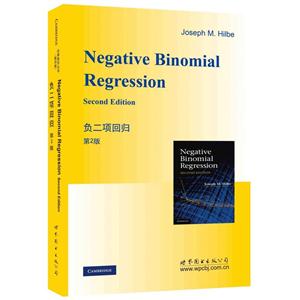负二项回归-第2版 版权信息
- ISBN:9787519205362
- 条形码:9787519205362 ; 978-7-5192-0536-2
- 装帧:一般胶版纸
- 册数:暂无
- 重量:暂无
- 所属分类:>>
负二项回归-第2版 本书特色
该书综述了计数模型和过度离散问题, 重点讲述了负二项回归。第2版比第1版增加了好多内容,提供了理论背景以及应用state和 r的计算实例,同时也提供了应用sas和limde的例子。该版本对任何需要选择、构建、阐释、比较评估计算模型的学者,尤其是负二项回归方面的,是一本不错的指导书。该书在概述了风险的性质、风险比和用在计数数据建模中的估计算法的本质,接着又对泊松模型进行了详尽的分析。
负二项回归-第2版 内容简介
该书综述了计数模型和过度离散问题, 重点讲述了负二项回归。第2版比第1版增加了好多内容,提供了理论背景以及应用State和 R的计算实例,同时也提供了应用SAS和LIMDE的例子。该版本对任何需要选择、构建、阐释、比较评估计算模型的学者,尤其是负二项回归方面的,是一本不错的指导书。该书在概述了风险的性质、风险比和用在计数数据建模中的估计算法的本质,接着又对泊松模型进行了详尽的分析。
负二项回归-第2版 目录
Preface to the second edition1 Introduction1.1 What is a negative binomial model
1.2 A brief history of the negative binomial1.3 Overview of the book2 The concept of risk2.1 Risk and 2×2 tables2.2 Risk and 2×k tables2.3 Risk ratio confidence intervals2.4 Risk difference2.5 The relationship of risk to odds ratios2.6 Marginal probabilities: joint and conditional3 Overview of count response models3.1 Varieties of count response model3.2 Estimation3.3 Fit considerations4 Methods of estimation4.1 Derivation of the IRLS algorithm4.1.1 Solving for □l or U— the gradient4.1.2 Solving for □2L4.1.3 The IRLS fitting algorithm4.2 Newton—Raphson algorithms4.2.1 Derivation of the Newton—Raphson4.2.2 GLM with OIM4.2.3 Parameterizing from/z to x'β4.2.4 Maximum likelihood estimators5 Assessment of count models5.1 Residuals for count response models5.2 Model fit tests5.2.1 Traditional fit tests5.2.2 Information criteria fit tests5.3 Validation models6 Poisson regression6.1 Derivation of the Poisson model6.1.1 Derivation of the Poisson from the binomial distribution6.1.2 Derivation of the Poisson model6.2 Synthetic Poisson models6.2.1 Construction of synthetic models6.2.2 Changing response and predictor values6.2.3 Changing multivariable predictor values6.3 Example: Poisson model6.3.1 Coefficient parameterization6.3.2 Incidence rate ratio parameterization6.4 Predicted counts6.5 Effects plots6.6 Marginal effects, elasticities, and discrete change6.6.1 Marginal effects for Poisson and negative binomial effects models6.6.2 Discrete change for Poisson and negative binomial models6.7 Parameterization as a rate model6.7.1 Exposure in time and area6.7.2 Synthetic Poisson with offset6.7.3 Example7 Overdispersion7.1 What is overdispersion
7.2 Handling apparent overdispersion7.2.1 Creation of a simulated base Poisson model7.2.2 Delete a predictor7.2.3 Outliers in data7.2.4 Creation of interaction7.2.5 Testing the predictor scale7.2.6 Testing the link7.3 Methods of handling real overdispersion7.3.1 Scaling of standard errors/quasi-Poisson7.3.2 Quasi-likelihood variance multipliers7.3.3 Robust variance estimators7.3.4 Bootstrapped and jackknifed standard errors7.4 Tests of overdispersion7.4.1 Score and Lagrange multiplier tests7.4.2 Boundary likelihood ratio test7.4.3 Rp2 and Rpd2 tests for Poisson and negative binomial models7.5 Negative binomial overdispersion8 Negative binomial regression8.1 Varieties of negative binomial8.2 Derivation of the negative binomial8.2.1 Poisson—gamma mixture model8.2.2 Derivation of the GLM negative binomial8.3 Negative binomial distributions8.4 Negative binomial algorithms8.4.1 NB-C: canonical negative binomial8.4.2 NB2: expected information matrix8.4.3 NB2: observed information matrix8.4.4 NB2: R maximum likelihood function9 Negative binomial regression: modeling9.1 Poisson versus negative binomial9.2 Synthetic negative binomial9.3 Marginal effects and discrete change9.4 Binomial versus count models9.5 Examples: negative binomial regressionExample 1:Modeling number of marital affairsExample 2:Heart proceduresExample 3:Titanic survival dataExample 4:Health reform data10 Alternative variance parameterizations10.1 Geometric regression: NB α=110.1.1 Derivation of the geometric10.1.2 Synthetic geometric models10.1.3 Using the geometric model10.1.4 The canonical geometric model10.2 NB 1: The linear negative binomial model10.2.1 NBI as QL-Poisson10.2.2 Derivation of NB110.2.3 Modeling with NB110.2.4 NB I:R maximum likelihood function10.3 NB-C: Canonical negative binomial regression10.3.1 NB-C overview and formulae10.3.2 Synthetic NB—C models10.3.3 NB-C models10.4 NB-H: Heterogeneous negative binomial regression10.5 The NB-P model: generalized negative binomial10.6 Generalized Waring regression10.7 Bivariate negative binomial10.8 Generalized Poisson regression10.9 Poisson inverse Gaussian regression (PIG)10.10 Other count models11 Problems with zero counts11.1 Zero-truncated count models11.2 Hurdle models11.2.1 Theory and formulae for hurdle models11.2.2 Synthetic hurdle models11.2.3 Applications11.2.4 Marginal effects11.3 Zero-inflated negative binomial models11.3.1 Overview of ZIP/ZINB models11.3.2 ZINB algorithms11.3.3 Applications11.3.4 Zero-altered negative binomial11.3.5 Tests of comparative fit11.3.6 ZINB marginal effects11.4 Comparison of models12 Censored and truncated count models12.1 Censored and truncated models-econometric parameterization12.1.1 Truncation12.1.2 Censored models12.2 Censored Poisson and NB2 models-survival parameterization13 Handling endogeneity and latent class models13.1 Finite mixture models13.1.1 Basics of finite mixture modeling13.1.2 Synthetic finite mixture models13.2 Dealing with endogeneity and latent class models13.2.1 Problems related to endogeneity13.2.2 Two-stage instrumental variables approach13.2.3 Generalized method of moments (GMM)13.2.4 NB2 with an endogenous multinomial treatment variable13.2.5 Endogeneity resulting from measurement error13.3 Sample selection and stratification13.3.1 Negative binomial with endogenous stratification13.3.2 Sample selection models13.3.3 Endogenous switching models13.4 Quantile count models14 Count panel models14.1 Overview of count panel models14.2 Generalized estimating equations: negative binomial14.2.1 The GEE algorithm14.2.2 GEE correlation structures14.2.3 Negative binomial GEE models14.2.4 GEE goodness-of-fit14.2.5 GEE marginal effects14.3 Unconditional fixed-effects negative binomial model14.4 Conditional fixed-effects negative binomial model14.5 Random-effects negative binomial14.6 Mixed-effects negative binomial models14.6.1 Random-intercept negative binomial models14.6.2 Non-parametric random-intercept negative binomial14.6.3 Random-coefficient negative binomial models14.7 Multilevel models15 Bayesian negative binomial models15.1 Bayesian versus frequentist methodology15.2 The logic of Bayesian regression estimation15.3 ApplicationsAppendix A:Constructing and interpreting interaction termsAppendix B:Data sets, commands, functionsReferences and further readingIndex
展开全部
负二项回归-第2版 作者简介
Joseph M. Hilbe(J. M. 希尔伯,美国)是国际知名学者,在数学界享有盛誉。本书凝聚了作者多年科研和教学成果,适用于科研工作者、高校教师和研究生。





















